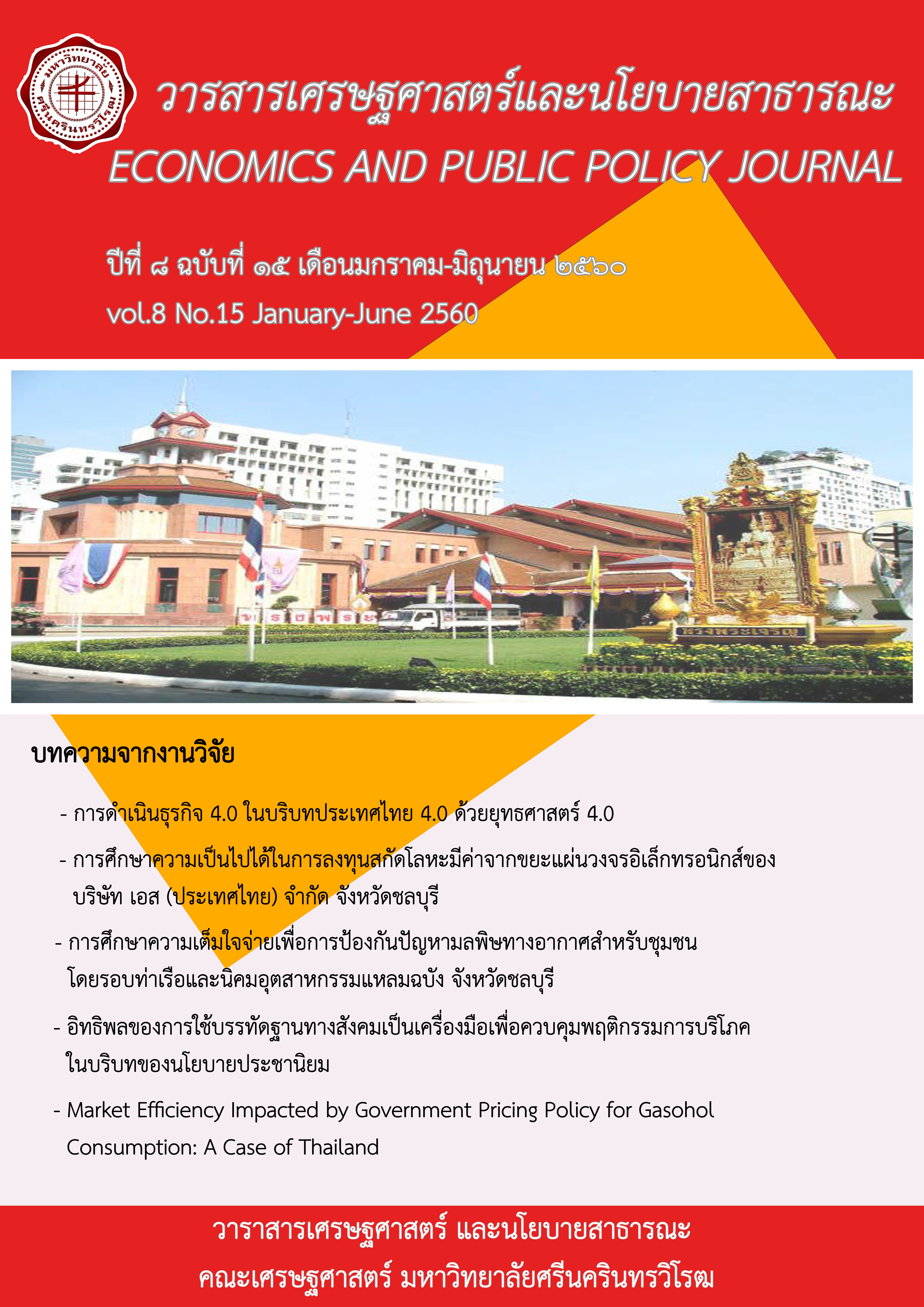Market Efficiency Impacted by Government Pricing Policy for Gasohol Consumption: A Case of Thailand
Main Article Content
บทคัดย่อ
The purpose of this study is to investigate market efficiency impacted by the Government pricing policy on gasohol products in Thailand which are taxed and subsidized by the Oil Fund to stabilize domestic fuel prices during the world oil price fluctuation. The period of study is 2004-2013. Deadweight losses are calculated via changes in consumer and producer surplus using Johansen cointegration tests and vector error correction models. The statistical results indicate that prices of gasohol 91, E20 and E85 are significantly elastic to its own consumption in the long run while price of gasohol 95 is significantly elastic to its own consumption in the short run. During 2004-2013 the total deadweight losses for gasohol 91, 95, E20, and E85 are 2937.63, 35611.81, 349.99, and 673.90 MTHB respectively while during 2009-2013 the total deadweight losses for gasohol 91, 95, E20, and E85 are 2348.09, 22861.09, 673.90, and 348.99 MTHB respectively. The highest deadweight loss occurs in the gasohol 95 market. The Government pricing policy is practical to promote using gasohol but it causes market inefficiency. The deadweight losses increase when oil fund tax or subsidy increase. The Government should float the fuel prices by ceasing the Oil Fund or reducing oil fund tax and subsidy as much as possible especially for gasohol 95 to minimize market inefficiency and maximize fairness of using fuels.
Article Details
สงวนลิขสิทธิ์ © 2553 คณะเศรษฐศาสตร์ มหาวิทยาลัยศรีนครินทรวิโรฒ
คณะเศรษฐศาสตร์ มหาวิทยาลัยศรีนครินทรวิโรฒ จัดพิมพ์วารสารเศรษฐศาสตร์และนโยบายสาธารณะ เพื่อเผยแพร่บทความวิชาการทางเศรษฐศาสตร์ นโยบายสารธารณะ และสาขาอื่นๆที่เกี่ยวข้อง ทัศนะและข้อคิดเห็นใดๆ ที่ปรากฏในวารสารเป็นความคิดเห็นส่วนตัวของผู้เขียน โดยบทความที่ได้รับการตอบรับจะถือเป็นลิขสิทธิ์ของคณะเศรษฐศาสตร์ มหาวิทยาลัยศรีนครินทรวิโรฒ
บรรณาธิการ อาจารย์ ดร.พลพัธน์ โคตรจรัส
เอกสารอ้างอิง
Chenphuengpawn, J. (2011). Dead-weight loss of alternative energy pricing policy: A case of high speed diesel (B0, B2, B3) and biodiesel B5 (Unpublished master’s thesis). National Institute of Development Administration, Bangkok.
Cuddington, J. T., & Dagher, L. (2011). A primer on estimating short and long-run elasticities: Energy sector applications.
Basso, L. J., & Oum, T. H. (2007, July). Automobile Fuel Demands: A Critical Assessment of Empirical Methodologies. Transport Reviews, 27, 449-484.
De Gorter, H., & Just, D. R. (2009). The economics of a blend mandate for biofuels. American Journal of Agricultural Economics, 91(3), 738-750.
Depro, B., Jones, K., Patil, S., Tom, W., & Wood, D. (2007). Economic Impact Analysis for the Gasoline Distribution Industry (Area Sources).
Franzen, M. (1994). Gasoline Demand: A Comparison of Models. Doctoral dissertation, University of Gothenburg.
Hausman, J. A., & Newey, W. K. (1993). Nonparametric estimation of exact consumer surplus and deadweight loss. Massachusetts: MIT.
Jirapraprisarn, S. (2007). The consumption of gasohol in Thailand (Unpublished master’s thesis). National Institute of Development Administration, Bangkok.
Johansson, O., & Schipper, L. (1994, September). Measuring Long-Run Automobile Fuel Demand: Separate Estimations of Vehicle Stock, Mean Intensity, and Distance Driven per Car per Year. Journal of Transport Economics and Policy, 31, 277-292.
Thongchuang, S., & Thungsuwan, S. (2010). The quantity analysis of gasohol E20 consumption in Thailand. BU Academic Review, 9, 47-55.
Vartia, Y. O. (1983, January). Efficient Methods of Measuring Welfare Change and Compensated Income in terms of Ordinary Demand Functions. Econometrica, 51, 79-98.
Vikitset, T. (2008). An alternative retail pricing policy for petroleum products: A case study of gasoline and high speed diesel in Thailand. Bangkok: National Institute of Development Administration.
Vikitset, T. (2010). Gasoline and high speed diesel consumption in Thailand: A Case Study in Welfare. Bangkok: National Institute of Development Administration.
Vikitset, T. (2014). Role of the oil fund in Thailand: Past, present, and future. Southeast Asian Journal of Economics, 2(1), 139-181.


